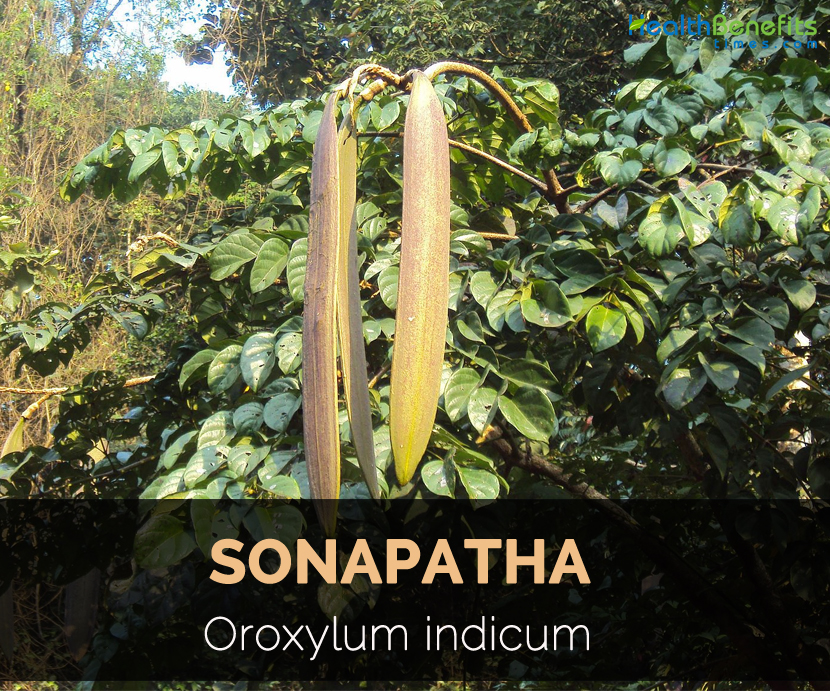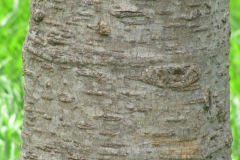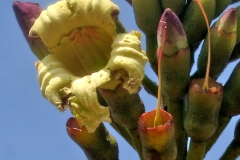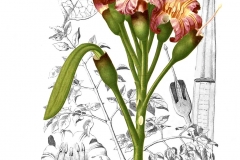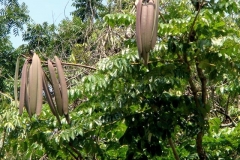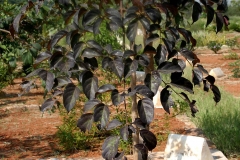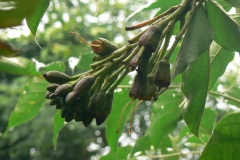The tree is small to medium sized deciduous tree that measures 12 meters high with soft and light brown bark having corky lenticels. It is a night bloomer with pinnate leaves which are about 1 meter long and wide borne on petioles or stalks upto 2 meters long. Flowers are followed by enormous seed pods (fruits) about 1.5 meters long which hang down from bare branches that resemble swords. Seeds are round having papery wings. Flowers are pollinated by bats.
Bark of Broken Bones Plant
The bark is brownish to grey and soft covered by various corky lenticels.
Leaves of Broken Bones Plant
Leaves are 2 to 3 pinnate having opposite pinnae which is very large about 3-7 cm long and ovate or elliptic. Leaflets are 2 to 4 pairs having terminal odd one, opposite, 7-17 x 3.5-10 cm lamina and ovate or elliptic and has glabrous texture. Apex is caudate to acuminate, asymmetric or rounded base, entire, glabrous and chartaceous margins.
Inflorescence / Flower of Broken Bones Plant
Flowers are large, reddish to purple and are pinkish to yellow inside.
Fruit and Seed of Broken Bones Plant
Flowers are followed by a flat, brown, 30 to 90 cm capsules which encompasses flattened seeds having hyaline papery wings.
Culinary uses of Broken Bones Plant
- Flowers and young leaves are consumed raw or cooked.
- Consume it as a side dish with rice and mixture of various spices including red onions, chillies, lemon grass, candle nut and ginger.
- Young shoots are cooked as vegetable.
- Cooked buds, flowers and young pods are eaten as vegetable.
- Young fruits are boiled and consumed with rice.
- Older fruits are grilled and added to curries.
- Grill unripe seeds and serve it with chili sauce.
Part Used
- Root
- Fruit
- Bark
- Leaves
- Stem
Traditional uses of Broken Bones Plant
- Root bark is a tonic, blood purifier and astringent.
- It is used for treating diarrhea, stomach complaints and dysentery.
- Apply alcoholic maceration of fresh bark externally on allergic dermatitis.
- Bark and seeds are used to alleviate body pain during fevers.
- Apply it to wounds and burns.
- Bark is used internally for treating dysentery and diarrhea.
- Bark decoction is used as a cure for jaundice and fevers.
- Drink leaf decoction for treating stomach ache.
- Use the decoction for gastritis, bronchitis and coughs.
- Apply the seeds externally to ulcers.
- In India, bark and seeds are used in pneumonia, fever and respiratory troubles.
- In Nepal, root decoction is used for dysentery and diarrhea.
- Apply the seeds paste to wounds and boils.
- Root bark is helpful for bile problems.
- Apply the seeds paste to wounds and boils.
- For earache, blend bark powder and water. Add it to sesame oil. Cook it in low flame till the oil is left. Put 2 to 3 drops of it in ears.
- For digestive health, soak the bark in one cup of water for 4 hours. Mash bark and filter the solution. Consume it twice a day.
- Use the decoction of root bark as a gargle for mouth blisters.
- Take 2 teaspoons of bark juice to cure diarrhea.
- For cough, take 1 gram of bark powder with honey and ginger.
- Take the mixture of bark powder, jaggery and dry ginger (in equal amounts) about 5 g thrice a day with Dashmula decoction for 2 to 3 weeks.
- Take ¼ grams of bark powder thrice a day for gout.
- In Philippines, root decoction is considered to contain antidysentric, antirheumatic and diuretic properties.
- In Thailand, root bark and root and useful for dysentery and diarrhea and stem bark is used for abscesses and ulcers.
- In Vietnamese folk medicine, seed decoction is used for bronchitis, cough and gastritis.
- Apply the seeds externally to ulcers.
- Decoction made from dried root bark or stem bark is used for treating allergic diseases, asthma, urticarial, hoarseness, laryngitis, sore throat, dysentery, gastralgia and diarrhea.
- Place the poultice on cheek to ease toothache or apply it to head to provide relief from headache.
- Use the leaves decoction internally to promote appetite.
- Roots are helpful for fever, cough and cold.
- Apply the seeds paste to wounds and boils.
- Apply the paste of bark powder for scabies, mouth cancer and skin problems.
- Apply the bark paste in the neck and throat for providing quick relief from tonsil pain.
- Use the fruits to cleanse wounds and also it detoxifies blood.
Dosage
- Water decoction – 40-80 ml
- Powder – 3-6 gm
Health Benefits of Sonapatha (Broken Bones Plant)
-
Prevent microbes
Sonapatha possess antibacterial properties. The ethyl acetate, methanolic and ethanolic extracts of stem bark is tested on various species of gram positive and negative bacteria such as E.coli, Bacillus subtilis and Pseudomonas aeruginosa. These extracts were shown to possess antibacterial properties. The dichloromethane extract was shown to possess antifungal activity. An ethanolic extract possess maximum activity against both strains of bacteria.
-
Antioxidant properties
The formation of oxidative species and free radicals associated with stress results adverse effects on various tissues of the body and vital organs. Antioxidants are effective in treating and preventing several diseases. Bark and leaves extract have maximum reductive ability and high free radical scavenging activities than stem, bark and fruit extract. The methanolic or aqueous extracts of stem bark possess diverse therapeutic properties. It has various properties such as cytotoxicity, antioxidant property and protection against oxidative damage and free radical scavenging activities. The extracts show extensive cytotoxicity in tested cell lines.
-
Lower inflammation
Root bark helped to lower chronic inflammation in rats. Study conducted on stem bark showed anti-inflammatory properties reducing ear swelling in mice. The water extract shows anti-inflammatory effects on reducing ear swell in mice. Aqueous extract of leaves relieves carrageenan induced rat paw edema.
-
Hepatoprotective activity
Sonapatha effectively protects liver against damages. The leaf extracts shows hepatoprotective activity against CCL4 induced hepatotoxicity in rats. An aqueous extract of root bark shows protective effect against paracetamol coaxed liver damage in experimental rats. This alter the levels of serum enzymes in experimental rats towards normal. The study confirms hepatoprotective activity of stem bark against CCI4 induced liver damage in mice.
-
Kidney health
Leaves and root decoction of Sonapatha is used as prophylaxis for kidney problems and eliminate kidney stones in Indian medicine. An ethanolic root extracts exhibits protective effect against cisplatin induced renal injury in rats. It is shown that various flavonoids possess nephroprotective activity. The experiment conducted on chrysin isolated from roots of Sonapatha evaluated for protective activities against cisplatin induced nephrotoxicity.
-
Helpful for diabetics
The antidiabetic properties of Sonapatha have been evaluated in animal models. The aqueous and methanolic extracts of leaves exhibits antidiabetic activity against alloxan induced diabetes in rats. The methanolic or aqueous extract at dose of 300 mg/kg for 21 days helps to restore serum biochemical parameters such as fasting level of blood glucose, biomarker enzymes, lipid profile, serum creatinine, serum total proteins, serum SGPT, SGOT and ALP to normal. When compared to aqueous extract, methanolic extract has more antidiabetic effect.
-
Strengthen immunity
An immunomodulatory activity is able to promote specific immune responses and antioxidant activities. The findings from the study conclude that root bark of Sonapatha possess significant immunomodulatory activity in comparison to stem bark counterpart. Powder of root bark is regarded to be safe and a beneficial immunomodulator.
-
Treatment for gastritis
For the ages, Sonapatha is used for treating various gastric problems. Study was conducted on protective effect of alcoholic extract of root bark and its different fractions i.e chloroform, pet ether, n-butanol and ethyl acetate fractions are studied against gastric ulcer in rats. Ethanol induced gastric mucosal damage in rats. The alcoholic extract reduces gastric ulceration against gastric damage showing n-butanol being more effective. Study shows the presence of baicalein, a flavonoid. Gastro protective activity lowers gastric acid secretary and antioxidant activity that led to gastric cytoprotection due to flavonoids.
-
Cancer prevention
Sonapatha shows anticancer activity in animal experiements by various types of carcinogens and in human cell lines by various experiments. An ethanolic extract shows antiproliferative effect on Hep 2 cell lines. Baicalein is a flavonoid found in Oroxylum indicum that have been isolated and tested on induction of apoptosis in HL-60 cell line. Study results shows baicalein’s anti-tumor effect on human cancer cells.
Precautions
- It is found to be safe to use in children and in lactation period.
- Pregnant women should use it under medical supervision.
References:
https://en.wikipedia.org/wiki/Oroxylum_indicum
http://www.plantnames.unimelb.edu.au/Sorting/Oroxylum.html
https://indiabiodiversity.org/species/show/16688
http://tropical.theferns.info/viewtropical.php?id=Oroxylum+indicum
https://pdfs.semanticscholar.org/03fa/a940187779d9b2123ce364aec9bf5f52dfd3.pdf
https://www.bimbima.com/ayurveda/medicinal-tree-shyonak-oroxylum-oroxylum-indicum/314/
https://www.wisegeek.com/what-are-the-medical-uses-of-oroxylum-indicum.htm
https://www.planetayurveda.com/library/shyonak-oroxylum-indicum/
https://aranyaani.in/resources/ecosystem/rare-herbs-and-plants/sonapatha/
https://www.researchgate.net/publication/285800921_Therapeutic_potential_of_Oroxylum_indicum_A_review
Comments
| Sonapatha Quick Facts | |
|---|---|
| Name: | Sonapatha |
| Scientific Name: | Oroxylum indicum |
| Origin | Indian subcontinent, the Himalayan foothills with a part extending to Bhutan and southern China, Indochina and the Malesia regions. |
| Shapes | Capsule, large, flat, sword shaped, 1 to 3 foot long, 2 to 4 inch broad |
| Name | Sonapatha |
|---|---|
| Scientific Name | Oroxylum indicum |
| Native | Indian subcontinent, the Himalayan foothills with a part extending to Bhutan and southern China, Indochina and the Malesia regions. |
| Common/English Name | Midnight horror, oroxylum, Indian trumpet flower, broken bones, Indian caper or tree of Damocles |
| Name in Other Languages | English: Indian calosanthes, Broken bones plant, Indian trumpet flower, Oroxylum, Midnight horror, Tree of Damocles; Bengali: Sona(সোনা); Chinese: Mu hu die (木蝴蝶), Hanyu pinyin; Hindi: Bhut-vriksha (भूत वृक्ष), Dirghavrinta (दीर्घवृन्त), Kutannat (कुटन्नट), Manduk (मण्डूक), Patrorna (पत्रोर्ण), Putivriksha (पूतिवृक्ष), Shallaka (शल्लक), Shuran (शूरण), Son (सोन), Son (शोण), Vatuk (वटुक); Kannada: Tattuna (ತಟ್ಟುನ); Konkani: Davamadak; Nepalese: Tatelo (टटेलों); Malay: Kampong; Malayalam: Palaqapayyani (പലകപയ്യാനി), Vashrppathiri (വാശ്പ്പാതിരി), Vellappathiri (വെള്ളപ്പാതിരി); Marathi: Tayitu (टायिटू), Tetu (टेटु); Russian: Oroksilum indijskij (Oроксилум индийский), Shionaka (Шионака); Sanskrit: Aralu (अरलु), Shyonaka (श्योनक) ; Tamil: Corikonnai (சொரிகொன்றை), Palaiyutaicci (பாலையுடைச்சி), Putapuspam (பூதபுஷ்பம்); Telugu: Manduka-parnamu (మండూకపర్ణము), Pampena (పంపెన), Sukanasamu (శూకనాసము), Tundilamu (తుందిలము); Thai: Lin fa ( ลิ้นฟ้า), Ka-do-dong (กาโด้โด้ง), Doka (ดอก๊ะ), Dokka (ดอก ก๊ะ), Du-kae (ดุแก), Pheka (เพกา), Ma lit mai (มะลิดไม้), Ma lin mai (มะ ลิ้นไม้) , Lit mai (ลิดไม้), Mak-lin-kang (หมากลิ้นก้าง), Mak-lin-sang (หมากลิ้นซ้าง); Vietnamese: Hoàng bá, Nam hoàng bá, Núc nác; Sanskrit: Aralu, Shyonaka; Sri Lanka: Totila, Thotila; Assamese: Bhatghila; Uttarakhand: Ullu ki Phali; Urdu: Sonapatha; Punjabi: Tatpaling, Talvarphali |
| Plant Size | 18 meters (59 ft) |
| Bark | Light greyish brown, soft, spongy |
| Leaves | Pinnate, 3-7 cm long, bipinnate or tripinnate ovate or elliptic |
| Flowering Season | January to March |
| Flower | Purple |
| Fruit shape & size | Capsule, large, flat, sword shaped, 1 to 3 foot long, 2 to 4 inch broad |
| Seed | Round, flat, thin, 3 inch in length and 2 inch in width |
| Taste | Astringent and bitter |
| Fruit Season | December to March |


